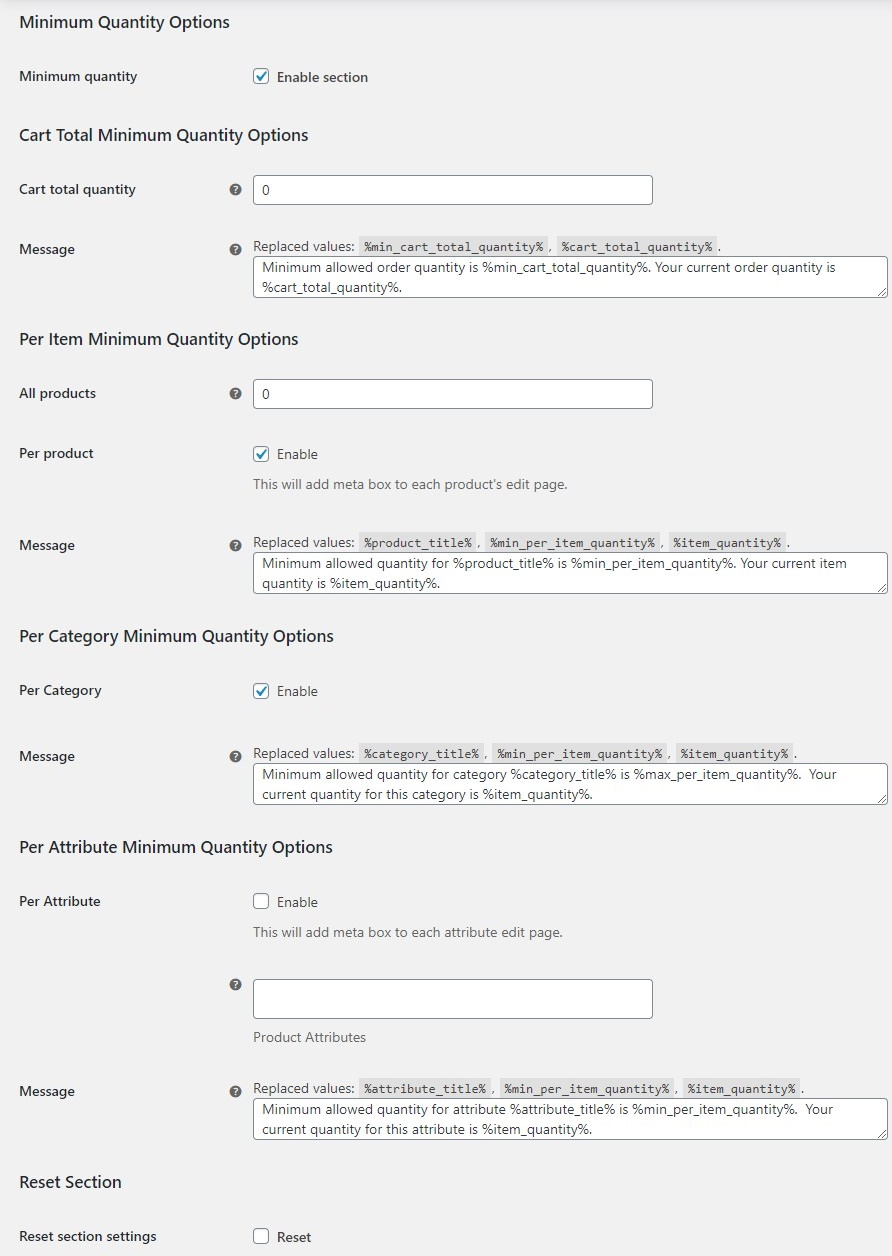Limiting Min/Max Quantity Per Product, Order, & Category in WooCommerce
A lot of stores need a functionality like that, specifying a minimum or maximum quantity whether for a product or for the order (cart) total quantity, and there are many ways to get that.
Some people prefer to do it manually, by adding a code that defines the minimum (or maximum) quantity for a product either using a code snippet or to a child theme function.php file.
There are many issues around this, mainly that the basic version of the code will be forced on the product page itself (i.e. doesn’t apply to cart), so customers can change quantity from cart, also it will take a lot of time to apply this to all your products, if you have a lot of them.
You can -of course- solve this issue by forcing validation on cart & checkout, but it will require a lot of work as there are hundreds of cases to catch, and no single code can maintain all that.
Thankfully, there are many plugins that are created to help with this, a quick search on Google or WordPress plugin repository will get you some ideas, in this post, we will be covering how you can define minimum & maximum product/order quantity for your WooCommerce store by using “All in One Product Quantity Plugin”.
How to Specify Minimum Quantity in WooCommerce?
First thing you need to do is to install the free plugin All-in-One Product Quantity for WooCommerce from the official WP plugins repository:
- After activating it, go to WooCommerce >> Settings >> Product Quantity, and then enable the section “Minimum Quantity“.
- You will be able to define a minimum quantity for all products at once by specifying a value on the field “All Products” under Per Item Minimum Quantity Options section, this will apply the value as a minimum quantity for all products in your store.
- To specify minimum order quantity (on the whole order level), you can add that value on the field “Cart Total Quantity” found on section Cart Total Minimum Quantity Options.
- To specify minimum quantity for a specific product, or a group of products (under a category or attribute), you can do so by enabling “Per Product / Per Category / Per Attribute” tick options, (this feature is available in the Pro version), this will create new fields under the respective page (product, category, attribute) where you will be able to define a value for each.

To have a better idea about various settings (if you haven’t installed the plugin yet), here is a screenshot for the Minimum Quantity section:

As you can see, the minimum value can be applied to simple products, as well as variables, but you get an extra feature on the variables:
You can define a minimum per each variation, or a minimum for all variations COMBINED! Once you enable minimum per product, you will get a specific field to define this value for the combination of all variations together.
Feel free to customize messages that will appear to customers when they try adding wrong quantities.
Use Cases for Specifying Minimum Quantity in WooCommerce
Countless, almost all types of online stores will find it useful, regardless of what they sell, specifying minimum quantity for all products or on cart (order) quantity can be helpful in achieving better margins, shipping cost saving, packaging needs, and others.
For example, a store sells fabric by yard, based on their product, they might need to sell in minimum of 2.4 yards (that’s how the fabric roll comes in), so in this case, they can just apply a minimum of 2.4 for all products in their store.
Another store, which sells spices need to sell for less than 1 KG, they sell it by 100 grams, but for their financial reports, they need to have the KG as default unit for their products.
One great thing about All-in-One Product Quantity plugin is that it allows you to use decimals in minimum & step quantity values, in this case, they will just need to enable “Decimal” from plugin general tab, and then define 0.1 as minimum quantity for all products, that’s it!
A third store sells different products, but they come in fixed-sized packaging that fits 6 products exactly, they can apply a rule to set minimum quantity of 6 for an order (cart level), and for better packaging, they also can define a step of 6 (available in the same plugin as well).
Some other stores will find it useful for shipping purposes, others can use it to increase sales, and the list goes on…
How to Specify Maximum Quantity in WooCommerce?
Defining maximum quantity is almost the same as a minimum, you can use the same plugin, enable the section “Maximum Quantity“, and then you will be able to define different rules of specifying a max value in WooCommerce.
You can enable it for all products, so customers can’t exceed that specified amount for any product in your store.
You can also have it configured on order (cart) level, customers in this case won’t be able to exceed that defined max value for the whole order, regardless of products quantities in cart.
The Pro version of the plugin will allow you to specify a maximum quantity on product by product, or category-based, or even attribute.
This can save you spending hours entering the maximum quantity for your products, one by one, you can even define a maximum for all products (to be specified one by one), or even define a total maximum for products in that category.
If you have products A, B, C in the category clothes, you can define a maximum of 10 for the category, and force customers to buy a maximum of 10 for the 3 products together (combined).
Use Cases for Specifying Maximum Quantity in WooCommerce
This feature might not be as needed as the minimum, but a lot of stores will find it very useful.
If you’re running a huge discount on your store, and you don’t want people (competitors?) from getting all your quantity (so you can still run the promotion), you can define a maximum value for a product, category, or even the whole order.
Also, if you want to maintain your stock so you don’t run out of stock very quickly, you will find limiting the maximum quantity for your customers very beneficial.
It might be also useful for shipping & logistic restrictions, some shipping packages/companies can have some limitations on the amount of products to be processed in an order (weight, dimensions, etc…).
Summary
Having the flexibility to define minimum/maximum quantities for your WooCommerce store is something that can take your online store to new levels.
It will allow you to properly handle stock, packaging, accounting, shipping logistics, and much more, feel free to try the free to try the All in One Product Quantity for WooCommerce plugin.
Or to get the ultimate features (define min/max per product, category, attribute), go PRO.






Hi! I bought the pro plugin and want to do the following.
At least 2 from category A or at least 3 from category B or at least 3 from categories A and B.
How do I set this up?
Thank you in advance!
Rudmer
Thank you for introducing this plugin and good article
Hola buenas tardes, compre el complemento Pro, necesito desactivar la opcion por metros cuadrados, para varias categorias como hago?
Hello Aitor,
Sorry for not responding earlier, we didn’t see the comment.
There are multiple ways to do it based on what features you’re using, can you please contact us at [email protected]? We will be glad to set this up for you.
Omar
Hi,
Is it possible with this plugin to establish a max/min quantity for the values of an attribute? For example, if the attribute is color, with black and white as colors, users only could buy one unit for black and one unit for white (two units in total for color atrribute).
Thanks.
Hi Victor,
Yes you can, the plugin allows setting these quantities based on attribute values the same way you described it.
We will be glad to help you set this up once you decide to get the plugin.
Omar